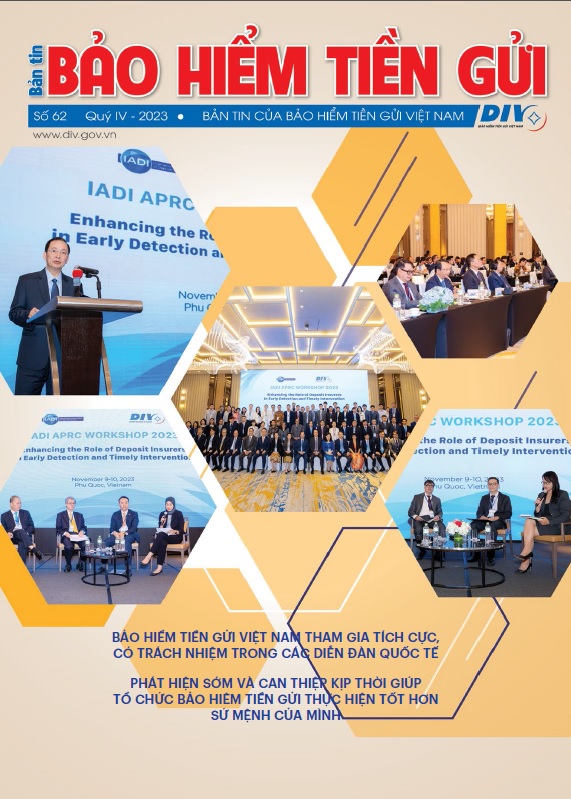Ensuring safe and efficient lending on digital platforms
To facilitate easier access to bank capital for people and enterprises, contribute to the provision of additional capital for production and business activities and restore economic development, on June 28, 2023, SBV issued Circular No. 06/2023/TT-NHNN amending and supplementing a number of articles of Circular 39/2016/TT-NHNN dated December 30, 2016 (Circular 39) which regulates credit institutions’ (CIs) lending activities to customers.
Circular 06 has added a separate section which specifically regulates CIs' lending activities on digital platforms to customers and amended, supplemented other terms which are more suitable for this form of loan. This will make conditions more favorable to CIs in their digital lending activities, ensuring safety and effectiveness. This is also consistent with the provisions of 2010 Law on Credit Institutions (amended and supplemented) and the banking industry's orientation and digital transformation policy in Decision No. 810/QD-NHNN dated May 11, 2021. Circular 06 will encourage CIs to apply more technological advancements and digital transformation in lending activities. This helps shorten the process and procedures, enabling customers to unnecessarily go to the bank, making it very easy and convenient to access loans in short time. These are regulations that will give positive signs for the development of consumer lending and business activities in Vietnam.
Some key contents on the regulation of lending activities on digital platform in Circular 06 include: stipulating principles of general application which is suitable for characteristics of CI's lending activities on digital platform, the identification and verification of customer identification information by electronic means ( eKYC); loan agreement in the electronic contract form; loan profiles which are established in the form of documents, electronic data, and profiles stored in digital environment; loan approval by electronic means (appraisal and loan giving decision); loan disbursement... CIs can freely decide the loan measures, forms of the loan and technology used in lending activities on digital platform; CIs can also consider and decide on giving loans on digital platform according to the provisions of the Circular.
Besides, in order to control the source of identification data in eKYC operations which provides the basis for lending activities on digital platform, SBV's regulations allow CIs to deploy eKYC of loan customers based on the utilization of personal identification data authenticated by responsible state agencies or with the national population database, citizen identification database or by organizations providing electronic authentication services in accordance with the law(s) regulating electronic identification and authentication. The allowed access and utilization of customer information from the national population database and citizen identification database enable CIs to have access to valuable source of official information.
This ensures healthy, transparent and safe eKYC activities and prompt prevention of risks of fraud, money laundering, crime; saving costs and social resources. At the same time, it is also consistent with the goal of researching and publicly implementing the application of population data and electronic identification/authentication in finance and banking (including lending activities) which was outlined in Decision No. 06/QD-TTg dated January 6, 2022 of the Prime Minister approving the Residential data applications, electronic identification and authentication development Project for national digital transformation in the period 2022-2025, with orientation to 2030, as well as plans and roadmaps in which SBV and CIs are actively coordinating with the Ministry of Public Security (direct responsible agency) to connect and utilize national population database, citizen identification database and VneID; test customer verification deployment solution, test data cleaning and customer ratings assistance in banking services. Furthermore, Circular 06 also regulates the mechanism allowing the implementation of eKYC based on the utilization of information that has been eKYC-processed by other credit institutions (which is the same as an eKYC opening a payment account). Thus, the data sources used for checking specified in Circular 06 are very diversified, official and reliable, and lay an important foundation to ensure safe and healthy eKYC operations which enables prompt prevention of fraud risks..
Besides, according to Circular 06, for loan demands which serves individuals and households' essential life needs and daily consumption purposes, (for example: car loan, consumer equipment purchase loan...) in which customers do not need to have plans or projects. dynamic, the customer's capital utilization plan only needs information on the needed total capital, capital usage purpose, capital usage period, and customer's debt repayment source(s), without having to construct specific plans and projects. For borrowing needs to buy houses, build and renovate houses; receiving transfer of land use rights to build houses (which is often of great value), new customers must add plans and projects in their loan application documents for this capital demand so that CIs have full information on the customers' loan purposes and to ensure supervision over the right-purpose usage of customers' loans.
Customers can borrow from one bank to repay loans at another bank
Circular 06 also introduces the regulation that CIs may consider and decide to provide loans to customers to repay loans at other CIs to serve life needs. specific, in current Circular 39/2016/TT-NHNN, customers are only allowed to borrow to repay loans at other CIs for loans serving production and business, not applicable to loans serving life needs. The improvement of regulations which allows customers to repay debt at other CIs applying to both loans serving business activities and life needs will facilitate customer access to more bank credit and allow customers to have more opportunities in choosing better services and utilities at other CIs (if any ). For example, an individual customer has outstanding debt on a home loan at bank A, but notices that the same home loan rate at bank B is lower than at bank A; while at the same time, there are additional incentives for some other services. Under this regulation, customers will be able to go to Bank B to propose their application for loan(s) to repay in advance the home loan that the customer is borrowing from bank A. Thus, customers can easily access new loans at lower costs and access and use new services.
On the part of commercial banks, microfinance institutions, people's credit funds, Vietnam Bank for Social Policies, and consumer finance companies, they have expanded their network, diversified products and services, reduced interest rates, and simplified lending procedures to meet the loan needs of businesses and all social strata. This contributes to increasing access to credit through official channels, especially for people in rural and remote areas, workers in industrial zones, and low-income stratum.
For example, Vietnam Bank for Agriculture and Rural Development has implemented a VND 5 trillion consumer credit program, in which customers with legitimate loan needs will be disbursed on the same day with a maximum loan amount of 30 million VND, without collateral…
By implementing social welfare policy, on October 4, 2002, the Government issued Decree No. 78/2002/ND-CP on matters related to credit for the poor and other policy beneficiaries. Then, on March 11, 2003, the Bank for Social Policies officially began its operation to provide capital to the poor and other policy beneficiaries. With the implementation covering 100% of villages, hamlets, and residential groups nationally, policy credit loans have brought livelihoods, created more jobs, and improved people's lives, promoted gender equality, while contributing to preventing the immoral practices of usury and "black credit" , helping to ensure social security, order and safety in localities, especially in rural, remote, border and ethnic minority areas.
Continuing to satisfy citizens' legitimate loan demands to serve life and consumption needs
Currently, SBV and the Ministry of Public Security are actively and closely coordinated to implement many solutions in fighting and preventing crime in banking activities as well as activities related to "black credit"; and have implemented Prime Minister's Decision No. 06/QD-TTg dated January 6, 2022 approving the residential data, electronic identification and authentication applications development Project to serve national digital transformation in the period 2022-2025, with orientation to 2030 (Project 06/QD-Ttg). composed, the State Bank of Vietnam and the Ministry of Public Security sign an agreement on the Plan to implement tasks in the Project (Plan 01) on April 24, 2023 with 11 major tasks detailing each operation such as: customer data cleaning, customer verification , credit scoring solutions… Therefore, the effective implementation of tasks in Plan 01 is important, contributing to implementing the Prime Minister's direction in Official Telegram 766/CD-Ttg. With the purpose of presenting solutions for vulnerable citizens to quickly access official capital, with appropriate interest rates, and help reduce crime and violations of the law governing "black credit", the Ministry of Public Security has assigned the Population Data and Citizen Identification Research and Application Center under the National Population Data Center to develop a solution to evaluate the credibility of borrowers.
In the coming time, SBV needs to continue to research and improve bank credit mechanisms and policies; direct CIs to diversify loan types; developing banking products and services with quick and convenient procedures, meeting people's legitimate loan demands to serve life and consumption need. Strengthen inspection, examination, supervision, and management of CI activities, payment intermediaries, and e-wallets to prevent criminals from engaging in "black credit" activities and have prompt handling of violations according to regulations. Continue to coordinate closely with the Ministry of Public Security in implementing Project 06, direct CIs in utilizing national population database and citizen identification database in review and authentication of bank accounts, coordinate to handle the misuse of "virtual" accounts for "black credit" activities .
In addition, SBV continues to coordinate closely with relevant ministries and ministerial agencies to promote personal data protection solutions; rigorously research, amend and complete relevant legal documents to improve the effectiveness of prevention and handling of "black credit" activities…
The banking sector needs to promote communication and disseminate the list of licensed CIs and microfinance institutions which are under the management of SBV, so that customers can thoroughly understand and do not mistake financial companies for application-based and internet-based lending companies and "black credit". Conduct public and official communication to people on debt repayment obligations and the risks of defaulting (failure to repay loans on time); Promote propaganda and communication of policies and credit products to ensure citizens of the security of SBV-licensed CIs and microfinance organizations' credit products and have confidence in accessing these products, thereby avoiding the "black credit" problem.
At the macro-level, Vietnam needs to perfect the legal framework to ensure harmony in both lenders and borrowers' exercizing of their legal rights and interests; and realized a more appropriate legal framework for non-bank lending institutions, and stronger sanctions for borrowers who are deliberately delinquent in repaying their debts.
Department of Research and International Cooperation (translation)

























